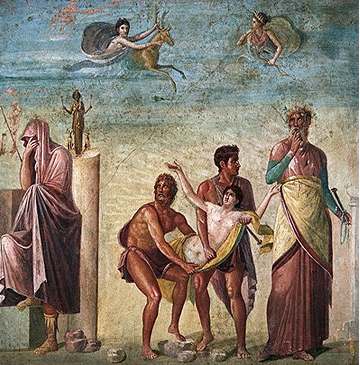When it comes to cocktails, I generally prefer an Old-Fashioned (with rye whiskey) or a Dirty Martini (with Vodka). My tastes in a drink lean heavily towards bitter and salty rather than sweet and syrupy, so you won't see me pounding Appletinis or Chocolate Banana Banshees. About a year ago, while searching for new Old-Fashioned variations, I came across the Negroni. A rather obscure
— almost forgotten
— cocktail, the classic Negroni is made by combining one part Campari bitters, one part Gin, and one part sweet red Vermouth. The drink is stirred over ice, served in an Old-Fashioned glass, and garnished with an orange slice. What results is a citrusy, exceptionally bitter apéritif, which really makes the mouth pucker.
The Negroni was purportedly invented in 1919 as a modification of the Americano, when Count Camillo Negroni
— a rodeo cowboy, no less!
— requested that the club soda component be replaced by gin, to strengthen the drink.[1]
As Eric Felten writes:
Count Negroni was in the habit of drinking Americanos, but he
found that it didn't have enough kick. The Americano is undeniably
suave and continental; in addition to being favored by James Bond at
Paris cafés, W. Somerset Maugham puts the drink in the hand of his
spy hero, Ashenden, too. But for all its impeccable charm, the
Americano is not a potent drink. Count Negroni was at his regular
watering hole in Florence, the Caffe Casoni, when he asked bartender
Fosco Scarselli to bolster his Americano with gin. The drink was a
success, and it soon spread to other bars in Florence, and beyond.
The Negroni is a bit obscure these days, but it is still a solid-enough standard in the cocktail canon that any bartender worthy of the title will know how to make it. Nor has the drink lost its vaguely illicit vibe
— it keeps turning up in the hands of ne'er-do-wells. Don't look for any Negronis in the movie version of Thank You for Smoking, but in Christopher Buckley's original novel, Vodka Negronis are the drink of choice for tobacco lobbyist Nick Naylor. And just as the Contessa's Negroni seems to signal a certain corruption, Naylor's Negronis suggest an indulgent moral rot.
What is it about the Negroni that makes it such a sinister accoutrement? There is the name, which is mysterious and exotic to
American ears. And then there is the deep ruby color of the drink. Not
only does the Contessa drink Negronis, everything in her flat—walls, sofas, curtains, lampshades—is that same infernal Campari crimson.
You could say the drink is a red flag.[2]
After reading about the Negroni (and seeing it ordered in the last episode of the Sopranos), my curiosity was piqued. I tried to order it in several local establishments, but the servers were clueless. It seems that most people in Northeast Ohio have never heard of the drink, or they don't have the Campari on-hand to make one. I'd nearly forgotten about the Negroni myself, until recently, when I was browsing the Gin selection in a local liquor agency and decided to make one at home.
The Negroni is certainly one of the more interesting cocktails I've tried. The drink's bitterness should not be underestimated. I make my Old-Fashioneds with a vigorous dose of Angostura, but was still caught off-guard by the acerbic bite of this cocktail. There are several other variations of the Negroni which I'd like to try. One can double the proportion of Gin, or substitute Vodka. The Campari can be swapped for another bitter apéritif, like Cynar. As with most other cocktails, possibilities for experimentation abound.
1. Regan, Gary.
Negroni history lesson ends in a glass. http://www.sfgate.com/cgi-bin/article.cgi?f=/c/a/2009/03/27/FD8R1696QJ.DTL&type=food
2. Felten, Eric.
How's Your Drink?: Cocktails, Culture, and the Art of Drinking Well.
Agate Publishing. 2007.
_












